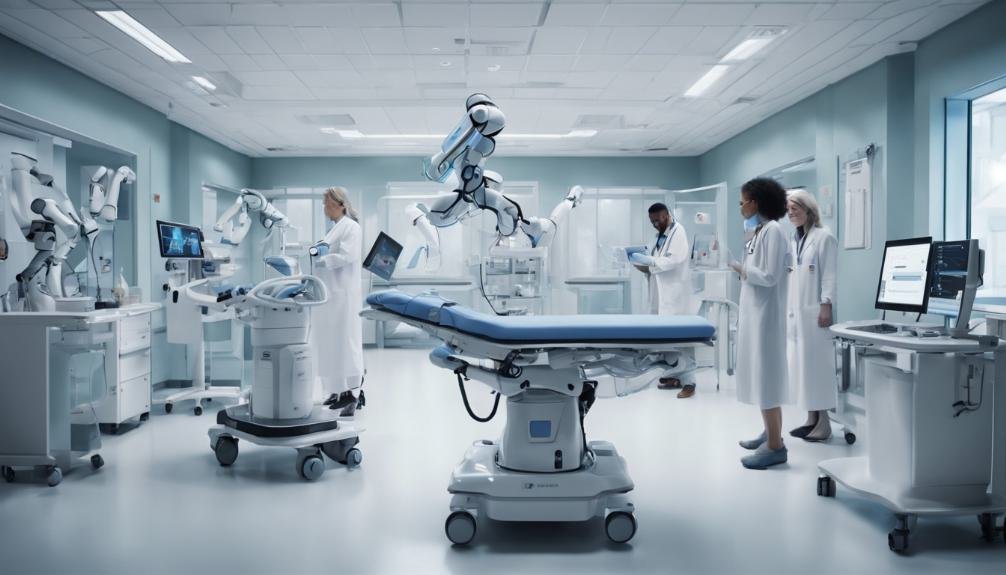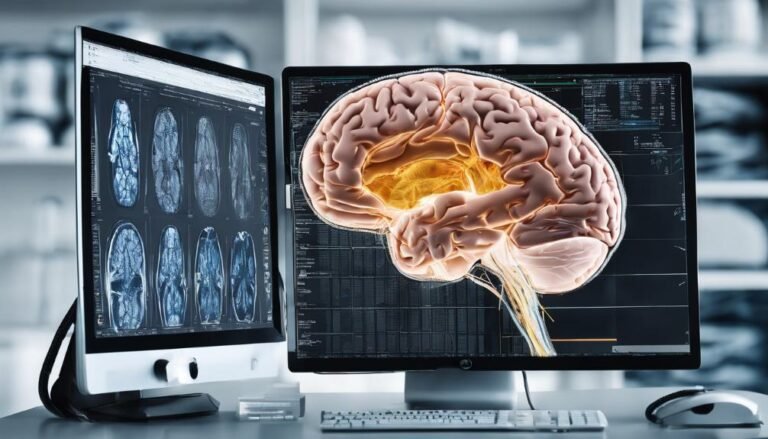AI for Health System Resilience
Enhancing health system resilience through the power of AI involves predictive analytics to anticipate trends, forecast outbreaks, and optimize resources. But have you considered the ethical implications and potential biases that could arise from relying heavily on artificial intelligence in healthcare decision-making? The intersection of technology and patient care raises vital questions around privacy, equity, and the human touch in medical practice that warrant exploration.
Key Takeaways
- Predicts emerging health trends for proactive planning.
- Enhances crisis response with real-time data analysis.
- Optimizes resource allocation for system resilience.
- Integrates technology for operational efficiency.
- Strengthens health system preparedness through AI utilization.
The Role of AI in Healthcare
AI plays a pivotal role in revolutionizing healthcare by enhancing diagnostic accuracy, streamlining administrative processes, and personalizing patient care. When it comes to AI diagnostics, the technology has shown remarkable capabilities in interpreting medical imaging, such as X-rays and MRIs, with a level of accuracy that rivals or even surpasses human experts. This not only expedites the diagnostic process but also reduces the chances of human error.
Remote monitoring is another area where AI shines brightly. By leveraging wearable devices and sensors, AI can continuously collect and analyze patient data in real-time. This enables healthcare providers to track essential signs, detect abnormalities, and intervene proactively, even when patients aren't physically present in a healthcare facility.
Remote monitoring powered by AI not only enhances patient safety but also allows for early intervention in case of any concerning developments, ultimately leading to better health outcomes. The integration of AI in remote monitoring systems is transforming the way healthcare is delivered, making it more efficient and effective.
Enhancing Patient Outcomes
You can enhance patient outcomes through treatment personalization, allowing for tailored healthcare plans based on individual needs.
Predictive analytics provides advantages by forecasting potential health issues, enabling proactive interventions to improve patient well-being.
Utilizing AI to personalize treatments and predict outcomes can lead to more effective and efficient healthcare delivery.
Treatment Personalization Benefits
Personalized treatment approaches have demonstrated significant benefits in enhancing patient outcomes within the healthcare system. By tailoring healthcare interventions to individual characteristics, personalized care has shown increased treatment effectiveness and improved outcomes.
Patient engagement plays an essential role in this process, as actively involving individuals in decisions regarding their care fosters a sense of empowerment and ownership over their health journey.
Studies have indicated that personalized care leads to better treatment adherence and higher patient satisfaction rates. When patients feel that their unique needs and preferences are taken into account, they're more likely to actively participate in their treatment plans. This heightened engagement often translates into improved health outcomes, including faster recovery times and reduced hospital readmission rates.
Furthermore, the data-driven nature of personalized treatment allows healthcare providers to make informed decisions based on individual patient profiles, optimizing the efficacy of interventions.
Predictive Analytics Advantages
Utilizing predictive analytics in healthcare has shown significant advantages in enhancing patient outcomes through data-driven decision-making and targeted interventions. By leveraging advanced algorithms, healthcare providers can conduct more accurate risk assessments, enabling proactive measures to be taken to prevent adverse events.
Predictive analytics also play an important role in early detection of potential health issues, allowing for timely interventions and improved patient outcomes.
Through the analysis of vast amounts of patient data, predictive analytics can identify patterns and trends that may indicate an increased risk of complications or diseases. This essential approach enables healthcare professionals to tailor treatment plans according to individual patient needs, ultimately leading to better outcomes.
Additionally, the early detection capabilities of predictive analytics can help in identifying subtle changes in patient health status, facilitating timely interventions and preventive measures. By harnessing the power of predictive analytics, healthcare systems can enhance patient outcomes, optimize resource allocation, and improve overall system resilience.
Streamlining Operations With AI
Enhancing operational efficiency through the strategic implementation of AI technology is essential for modernizing and optimizing health systems. Efficiency optimization and workflow automation are key components in streamlining operations with AI in healthcare.
By leveraging AI algorithms, tasks such as patient scheduling, resource allocation, and inventory management can be automated, reducing human error and saving valuable time.
AI can analyze vast amounts of data to identify operational bottlenecks, predict equipment maintenance needs, and streamline administrative processes. For example, predictive analytics can help in forecasting patient admission rates, allowing hospitals to adjust staffing levels accordingly and optimize bed utilization.
Furthermore, AI-powered chatbots and virtual assistants can enhance patient experience by providing instant responses to inquiries, scheduling appointments, and offering guidance on healthcare services. This not only improves patient satisfaction but also lightens the workload for healthcare staff, allowing them to focus on more critical tasks.
In essence, integrating AI into healthcare operations can lead to significant improvements in efficiency and overall system performance.
Predicting Health Trends
You can utilize AI to predict health trends by forecasting disease outbreaks, analyzing patient demographics, and monitoring healthcare resource allocation.
By leveraging advanced algorithms and data analytics, AI can help healthcare systems anticipate and prepare for potential health challenges more effectively.
This proactive approach enables better decision-making, resource management, and ultimately improves overall health system resilience.
Forecasting Disease Outbreaks
Forecasting disease outbreaks is a critical component of predicting health trends and enabling proactive public health interventions. Through epidemic modeling and data visualization, public health officials can anticipate the spread of infectious diseases and implement timely interventions. Technology integration plays a pivotal role in enhancing the accuracy and efficiency of these forecasting efforts. By leveraging advanced algorithms and real-time data analysis, AI systems can predict potential disease outbreaks with greater precision.
Epidemic modeling involves simulating the spread of diseases based on various factors such as population density, travel patterns, and healthcare resources. These models provide valuable insights into how infectious diseases may propagate within communities, allowing health authorities to allocate resources effectively. Data visualization tools further enhance understanding by presenting complex data in easily interpretable formats, aiding in decision-making processes.
Analyzing Patient Demographics
Analyzing patient demographics provides essential insights for predicting health trends in populations, guiding strategic healthcare decision-making.
By utilizing data visualization techniques, healthcare providers can gain a thorough understanding of the characteristics and needs of different population groups. Population analysis allows for the identification of trends related to specific health conditions, risk factors, and social determinants of health within communities.
Through data visualization tools, such as charts, graphs, and heat maps, patterns and correlations within patient demographics become more apparent. These visual representations enable healthcare professionals to make informed decisions regarding resource allocation, intervention strategies, and preventive measures.
Understanding the distribution of age, gender, ethnicity, socioeconomic status, and geographic location among patients is critical for tailoring healthcare services effectively.
Population analysis not only aids in predicting potential health challenges but also facilitates the development of targeted healthcare programs aimed at improving outcomes and reducing disparities. By harnessing the power of patient demographic data, healthcare systems can proactively address emerging health trends and enhance overall system resilience.
Monitoring Healthcare Resource Allocation
Effective monitoring of healthcare resource allocation is essential for predicting emerging health trends and ensuring the best possible preparedness within the health system. By implementing advanced technologies for resource optimization and allocation monitoring, healthcare facilities can enhance their capacity management and streamline their operations.
Through data-driven approaches, such as demand forecasting models powered by artificial intelligence, hospitals can accurately anticipate the need for medical supplies, staff, and infrastructure adjustments.
Allocation monitoring allows for real-time adjustments to be made based on current demands, optimizing the allocation of resources to where they're most needed. This proactive approach enables healthcare systems to respond swiftly to fluctuations in patient numbers and medical requirements, ultimately improving patient care and overall system resilience.
Leveraging Data Analytics
Utilizing advanced data analytics techniques can greatly enhance the efficiency and effectiveness of health systems in managing resources and optimizing patient care. When leveraging data analytics in healthcare, it's important to address data security and privacy concerns to guarantee that patient information remains protected. Implementing robust encryption methods and access controls can mitigate the risks associated with unauthorized data breaches.
Moreover, ethical implications must be carefully considered when utilizing data analytics in health systems. Bias detection mechanisms should be integrated into the analytics process to identify and rectify any biases that may be present in the data. By actively monitoring and addressing biases, health systems can ensure fair and equitable treatment for all patients.
Incorporating these measures not not only improves the quality of care provided but also enhances the overall trust in the health system. By harnessing the power of data analytics while prioritizing data security, privacy, ethical considerations, and bias detection, health systems can make informed decisions that positively impact patient outcomes.
Strengthening Crisis Response
Improving crisis response in health systems requires a holistic strategy that integrates real-time data analysis with proactive decision-making. Emergency preparedness plays an essential role in ensuring a swift and effective response during times of crisis.
By adopting a data-driven approach, health systems can enhance their resilience and preparedness to handle unexpected events efficiently. Technology integration further strengthens crisis response capabilities by enabling quick access to critical information and facilitating coordination among healthcare providers.
Utilizing advanced analytics tools allows health systems to monitor key indicators in real-time, detect anomalies, and predict potential crises before they escalate. This proactive approach enables healthcare organizations to allocate resources effectively, streamline communication channels, and optimize patient care during emergencies.
Automation in Healthcare
To enhance crisis response capabilities in health systems, incorporating automation into healthcare processes can greatly improve efficiency and accuracy in managing patient care and operational tasks. Automation plays an important role in streamlining healthcare procedures, especially during times of crisis.
Through remote monitoring technologies, healthcare providers can keep track of patients' essential signs and health metrics without constant physical presence, allowing for timely interventions and reducing the risk of complications. Additionally, telemedicine advancements enable healthcare professionals to deliver remote care and consultations efficiently, minimizing the need for in-person visits and reducing the strain on healthcare facilities.
Automation in healthcare not only enhances the quality of patient care but also optimizes operational efficiency. By automating routine tasks such as appointment scheduling, billing, and inventory management, healthcare facilities can allocate resources more effectively, improve workflow processes, and minimize human errors.
Conclusion
To sum up, AI has become a game-changer in healthcare, revolutionizing the way we predict, manage, and respond to health crises.
By harnessing the power of data analytics and automation, healthcare systems can proactively adapt and strengthen their resilience in the face of uncertainty.
As the saying goes, 'forewarned is forearmed,' and with AI at the forefront, we're better equipped to navigate the complex challenges of tomorrow.







